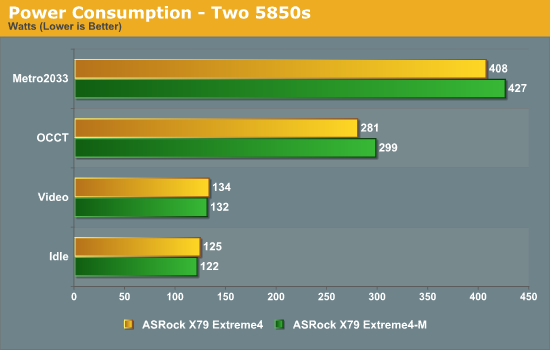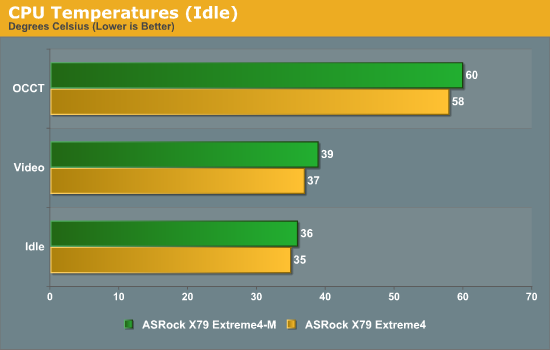ASRock X79 Extreme4-M and X79 Extreme4 Review – Sandy Bridge-E meets mATX
by Ian Cutress on December 9, 2011 12:00 PM EST- Posted in
- Motherboards
- ASRock
- X79
Test Setup
| Processor |
Intel Sandy Bridge-E i7-3960X 6 Cores, 12 Threads, 3.3 GHz (3.9 GHz Turbo) |
| Motherboards |
ASRock X79 Extreme4-M (mATX) ASRock X79 Extreme4 (ATX) |
| Cooling | Intel All-In-One Liquid Cooler, made by Asetek |
| Power Supply | Silverstone 1000W 80 PLUS Silver |
| Memory | G.Skill RipjawsZ DDR3-2133 9-11-9 28 4x4 GB Kit 1.65V |
| Memory Settings | XMP |
| Video Cards |
XFX HD 5850 1GB ECS GTX 580 1536MB |
| Video Drivers |
Catalyst 11.8 NVIDIA Drivers 285.62 |
| Hard Drive | Micron RealSSD C300 256GB |
| Optical Drive | LG GH22NS50 |
| Case | Open Test Bed - CoolerMaster Lab V1.0 |
| Operating System | Windows 7 64-bit |
| SATA Testing | Micron RealSSD C300 256GB |
| USB 2/3 Testing | Patriot 64GB SuperSonic USB 3.0 |
Comparison to Other Reviews
Where applicable, the results in this review are directly compared to the following chipsets and boards which we have reviewed previously.
Power Consumption
Power consumption was tested on the system as a whole with a wall meter connected to the power supply, while in a dual GPU configuration. This method allows us to compare the power management of the UEFI and the board to supply components with power under load, and includes typical PSU losses due to efficiency. These are the real world values that consumers may expect from a typical system (minus the monitor) using this motherboard.

In low power usage, the mATX uses less power, however in large usage scenarios, it uses more. This could be due to the GPU spacing - the Extreme4 has an extra slot gap between the GPUs, meaning there is some airflow, and the fans do not have to work as hard. That wouldn't really affect OCCT though, so I'm unsure where exactly the difference would be in this regard.
CPU Temperatures
With most users running boards on purely default BIOS settings, we are running at default settings for the CPU temperature tests. This is, in our outward view, an indication of how well (or how adventurous) the vendor has their BIOS configured on automatic settings. With a certain number of vendors not making CPU voltage, turbo voltage or LLC options configurable to the end user, which would directly affect power consumption and CPU temperatures at various usage levels, we find the test appropriate for the majority of cases. This does conflict somewhat with some vendors' methodology of providing a list of 'suggested' settings for reviewers to use. But unless those settings are being implemented automatically for the end user, all these settings do for us it attempt to skew the results, and thus provide an unbalanced 'out of the box' result list to the readers who will rely on those default settings to make a judgment. Ultimately, it all comes down to design – if a manufacturer has put thicker copper in its power plane, there is less resistance, and thus a higher voltage (and possibly temperature) at the CPU, but a higher overclockability, perhaps.

Overall CPU temperatures are within range for the two boards.










54 Comments
View All Comments
DanNeely - Friday, December 9, 2011 - link
A lot more of them do have reasons to be migrated than you'd think. Even 5 years ago I started seeing L shaped cards at the low end ( a tiny strip of PCB along the bracked, and a second for the PCI plug); chopping the 2nd half of the L cuts manufacturing costs by an amount that more than pays for the engineering over larger production runs.Devices that need larger PCBs but which have minimal bandwidth needs are an ever shrinking segment of the market. Even when total bandwidth isn't an issue the fact that PCIe bandwidth is dedicated instead of being shared means you no longer need to put as much hardware into buffering to avoid latency bursts when something else is using the bus more heavily.
Finally, once legacy PCI starts disappearing on a non-trivial fraction of boards total collapse from mainstream devices is inevitable. Once supporting PCIe becomes mandatory it's only a matter of time until redesigning the core chip on the card to be native PCIe instead of PCI and using a PCI-PCIe bridge chip becomes the cheaper option (probably with the next scheduled redesign). While they might initially maintain back compatability with a bridge chip going the other direction; however being doublely niche parts AGP gfx cards from 3 or 4 generations ago is probably a good comparison example. nVidia didn't make any at all, and the handful of ATI 3xxx/4xxx cards went at significant price premiums.
Eventually it'll end up like ISA; if you're willing to pay a large enough price premium (eg because the industrial/lab equiptment you're controlling costs thousands or millions of dollars to replace) there will be a handful of companies willing to sell you semi-custom boards at a large price premium and technology lag. The last time I looked I couldn't find ISA on anything newer than LGA775, until after intel finally pulls the plug on the last 775. That probably won't be for a while; if you look at their CPU database intel hasn't discontinued its embedded p4's yet, and probably won't file a while. IIRC they typically have contractual agreements to keep embedded parts in stock for a decade.
darckhart - Friday, December 9, 2011 - link
nope. still useful for pci graphics cards for troubleshooting video probs.Blibbax - Friday, December 9, 2011 - link
The differences in load power consumption might just demonstrate the margin of error on that test. Worth keeping in mind for other comparisons.The other possibilities are that the 5850s use a lot more power when they're a little bit hotter, and that the power circuitry on the M-ATX board is just awful under high load.
Concillian - Friday, December 9, 2011 - link
I was reading through the article and thought I had hit back instead of forward since I had read the page I was reading before.After finding all my marbles, I noticed that the article has two sets of Page 2 & 3. page order is 1, 2, 3, 2, 3, 4, 5...
hal74 - Friday, December 9, 2011 - link
I am always disappointed to find an article written by Ian. I know that I'll get an article written by someone who fails at plural vs singular when talking about a company and who doesn't come up with interesting comparison charts. Ian chose to throw in an E350 into the mix and didn't even add any comparisons with an x58, or any other core i7. Also, whats with fascination with older video cards in SLI?Is this seriously what people want in an article from Anandtech?
Spivonious - Friday, December 9, 2011 - link
Usually, I'll let grammar mistakes slide, but when I find multiple mistakes on a single page it really starts distracting me from the material.Can we get editors for the articles written by non-native English speakers?
Spivonious - Friday, December 9, 2011 - link
And "tenacity" is used incorrectly."...given ASRock’s previous tenacity when it comes to box bundling."
Does this make sense?
"...given ASRock's previous stubbornness when it comes to box bundling."
JonnyDough - Friday, December 9, 2011 - link
Yes. It does. Maybe your reading comprehension is lacking. The sentence means that ASRock will not budge when it comes to box bundling.Can we get some editors for the comments written by non-literate English readers?
Spivonious - Friday, December 9, 2011 - link
"3.2 GiB limit of 32-bit"*scratches head*
I thought 2^32-1 was 4GiB...
Aisalem - Friday, December 9, 2011 - link
using 32-bit you are able to address 4GB but unfortunately you will not be able to use whole 4GB in most of the 32-bit Windows installations, that also depend on the additional hardware you have.Now you shouldn't *scratches head*.